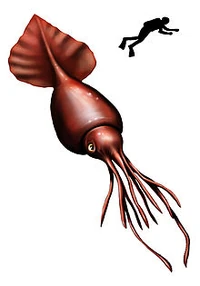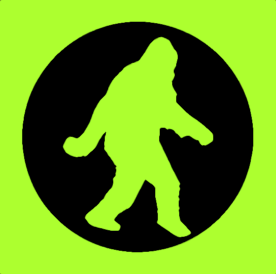| Scientific Classification | |
|---|---|
 | |
|
Kingdom |
Animalia |
|
Phylum |
Mollusca |
|
Class |
Cephalopoda |
|
Order |
Teuthida |
|
Family |
Cranchiidae |
|
Subfamily |
Taoniinae |
|
Genus |
Mesonychoteuthis |
|
Species |
M. hamiltoni |
The Colossal Squid (Mesonychoteuthis hamiltoni, from Greek mesos {middle}, nychus {claw}, and teuthis {squid}) sometimes called the Antarctic or giant cranch squid, is believed to be the largest squid species in terms of mass. It is the only known member of the genus Mesonychoteuthis. It is known from only a few specimens, and current estimates put its maximum size at 12–14 m (39–46 ft) long, based on analysis of smaller and immature specimens, making it the largest known invertebrate.
Unlike the giant squid, whose arms and tentacles only have suckers lined with small teeth, the colossal squid's limbs are also equipped with sharp hooks: some swiveling, others three-pointed. Its body is wider and stouter, and therefore heavier, than that of the giant squid. Colossal squid are believed to have longer mantles than giant squid, although their tentacles are shorter.
The squid exhibits abyssal gigantism. The beak of M. hamiltoni is the largest known of any squid, exceeding that of Architeuthis (giant squid) in size and in robustness. The colossal squid also has the largest eyes documented in the animal kingdom; a partly collapsed specimen measured 27 cm (11 in).
It was first discovered at 1925 in the form of two tentacles found in the stomach of a sperm whale.
Early Sightings
- In 1802, over 50 years before the Giant Squid was officially recognized, an enormous squid was sighted off the coast of Tasmania (The upper-most range of the Colossal Squid) by French navigator Péron.
- In 1870, on the coast of New Zealand (The upper range of the Colossal Squid), a large squid carcass washed ashore. Mr. Meinertzhagen sent beak, saved by third party (unidentified), to Kirk. Natives called specimen a "Taniwha".
- In 1871, a year later, a similar sighting was made off of New Zealand.
- In 1876, a large squid washed ashore on Clifford Bay, Cape Campbell, New Zealand (The upper range of the Colossal Squid).
- In 23 May 1879, a large squid washed ashore on Lyall Bay, Cook Strait, New Zealand near the site of the 1870 sighting.
- In 1880, three large squids were caught by fishing party off of New Zealand.
- In 30 June 1886 and "early" October 1887, two large squids were recovered by fishermen.
- In 9 October 1924, a year before the official discovery of the Colossal Squid, a large squid was sighted at the southern-most tip of South Island near Bluff, New Zealand (well within the Colossal Squid's range).
Discovery
- In 1925, the Colossal Squid was officially discovered by Robson from a sperm whale stomach.
Today
Today the Colossal Squid is one of the most seclusive creatures in the world; with just 24 sightings since its discovery.


